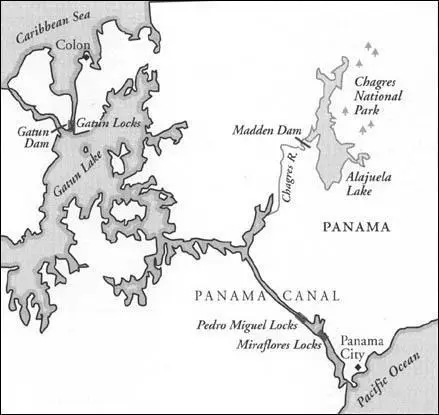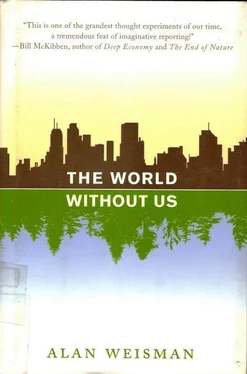That sealed the United States’ reputation in Latin America as piratical gringo imperialists, and produced—11 years and 5,000 more deaths later—the most stunning engineering feat yet in human history. More than a century has passed and it is still among the greatest of all time. Besides reconfiguring continental landmasses and communication between two oceans, the Panama Canal also significantly shifted the economic center of the world to the United States.
Something that substantial and literally earth-moving seems destined to last for the ages. But in a world without us, how long would it take nature to rejoin what man split asunder in Panama?

“THE PANAMA CANAL,” says Abdiel Pérez, “is like a wound that humans inflicted on the Earth—one that nature is trying to heal.”
As superintendent of the locks on the Canal’s Atlantic side, Pérez—along with 5 percent of all planetary commerce—depends on a handful of hydrologists and engineers charged with keeping that wound open. A square-jawed, soft-voiced electrical and mechanical engineer, Pérez began here in the 1980s as an apprentice machinist while studying at the University of Panama. Daily, he feels humbled to be entrusted with one of the most revolutionary pieces of machinery on Earth.
“Portland cement was a novelty. This is where it was tried out. Reinforced concrete wasn’t invented yet. All the walls of the locks are oversized like a pyramid. Their only reinforcement is gravity.”
He stands alongside what is essentially a huge concrete box, into which an orange Chinese freighter bound for the East Coast of the United States, stacked seven stories high with containers, has just been guided. The lock is 110 feet wide. The ship, as long as three football fields, has exactly two feet of clearance on each side as two electric railway engines, called mules , tug it through the glove-tight locks.
“Electricity was also new. New York had barely installed the first generating plant. But the Canal builders decided to use electricity, not steam engines.”
Once the ship is inside, water is piped into the lock to raise it 28 feet, which takes ten minutes. On the lock’s opposite end awaits Lake Gatun, for a half-century the biggest artificial lake in the world. Creating it drowned an entire mahogany forest, but prevented a repeat of the French debacle, which resulted from the fatal decision to try digging another sea-level canal like Suez. Besides entailing removal of a large chunk of the continental divide, there was also the matter of the Río Chagres, a rain-gorged river that, as it plunged from jungle highlands to the sea, smacked into the middle of the canal’s route. During Panama’s eight-month rainy season, the Chagres carried enough silt to plug a narrow man-made channel in mere days, if not hours.
The Americans’ solution was to build an aquatic staircase fashioned by three locks on either end, rising in watery steps to a lake formed by the dammed Chagres in the middle—a liquid bridge over which boats could float across the hills that the French failed to cut through. The locks use 52,000 gallons of water to lift every ship that passes through—freshwater fed by gravity from the trapped river, which drains to the sea as each vessel exits. Although gravity is always available, the electricity that opens and closes the doors of each lock depends on human operators who maintain hydroelectric generators that also tap the Chagres.
There are also auxiliary steam power and a diesel plant, but, says Pérez, “without people, the electricity wouldn’t last a day. Someone in control must decide where the power’s coming from, whether to open or close turbines, et cetera. With no human in the system, it doesn’t work.”
What particularly wouldn’t work are the 7-foot-thick hollow, floating steel doors, 80 feet high and 65 feet wide. Each lock has a double set as backup, pivoting on plastic bearings that, during the 1980s, replaced the original brass hinges that corroded every few decades. What if power were cut, and the doors opened and stayed that way?
“Then it’s all over. The highest lock is 137 feet above sea level. Even if they were left closed, once their seals went, so would the water.” The seals are steel plates overlapping each door’s leading edge, which need replacing every 15 to 20 years. Pérez glances up as the shadow of a frigate bird speeds past, then resumes watching the double doors close behind the departing Chinese freighter.
“The whole lake could empty through the locks.”
Gatun Lake sprawls over what was once the course of the Río Chagres as it emptied into the Caribbean. Reaching it from the Pacific side required cutting through the 12 miles of terrestrial spine that bisects Panama lengthwise at La Culebra, the lowest saddle in the continental divide. Slicing through that much soil, iron oxide, clay, and basalt would have been daunting anywhere, but even after the French disaster, no one really understood how truly unstable the waterlogged Panamanian earth was.
The Culebra Cut initially was to be 300 feet wide. As one gigantic mudslide after another undid months of digging, sometimes burying boxcars and steam shovels as it refilled the trench, engineers had to keep widening the slope. In the end, the mountain range that runs from Alaska to Tierra del Fuego was separated in Panama by a man-made valley, its gap about six times as broad as its floor. To dig it required the labor of 6,000 men every day for seven years. The 100 million-plus cubic yards of dirt they moved, if compacted together, would form an asteroid one-third of a mile across. More than a century since its completion, work on Culebra Cut has never entirely ceased. With silt constantly accumulating, and frequent small landslides, each day dredging rigs with suction pumps and shovels work up one side of the canal as ships come down the other.
In the green mountains 20 miles northeast of the Culebra Cut, two Panama Canal hydrologists, Modesto Echevers and Johnny Cuevas, stand on a concrete abutment above Lake Alajuela, created by yet another dam, one that had to be built upriver on the Chagres in 1935. The Chagres watershed is one of the rainiest places on Earth, and during the Canal’s first two decades, several floods slammed into it. Boat traffic halted for hours while floodgates were opened, lest the pounding of the river cave in its banks. The flood of 1923, which carried entire uprooted mahogany trunks, created a surge on Lake Gatun powerful enough to tip over ships.
Madden Dam, the wall of concrete that holds back the river to form Lake Alajuela, also sends electricity and drinking water to Panama City. But to keep its reservoir from leaking out the sides, engineers had to fill 14 dips in the terrain with earth to create its rim. Down below, massive Lake Gatun is also surrounded by earthen saddle dams. Some are so overgrown with rain forest that an untrained eye can’t see that they are artificial—which is why Echevers and Cuevas must come up here every day: to try to stay ahead of nature.
“Everything grows so fast,” explains Echevers, a burly man in a blue rain jacket. “When I started doing this, I came here looking for Dam Number 10, and I couldn’t find it. Nature had eaten it.”
Cuevas nods, eyes closed, recalling many battles with roots that can tear an earthen dam apart. The other enemy is the trapped water itself. During a rainstorm, these men are often here all night, fighting to maintain a balance between holding the Chagres at bay and releasing enough water through the concrete wall’s four floodgates to assure that nothing bursts.

Map of Panama Canal.
MAP BY VIRGINIA NOREY
But if one day there were no people around to do that?
Читать дальше













